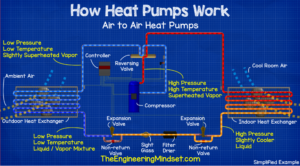Heat Pumps and Their Benefits During the Winter Season
What is a Heat Pump?
A heat pump is a device that is typically fixed outside of your home and is designed to keep your house at a comfortable temperature by moving warm air into your home in the winter and out during the summer. It takes in thermal energy and transfers it from a cold state to a hot state (in the winter months and the opposite in the summer) using a refrigeration cycle.
How does a Heat Pump Work?
Heat pumps take in heat from the air or ground, also known a thermal energy and transfer it into a heat exchanger (tube and fin, shell and tube, or braze plate) that contains liquid refrigerant. The refrigerant works to absorb the outdoor heat and transfer a liquid state into a low-pressure, low-temperature gas.
See image below to view the complete cycle:
Different Types of Heat Pumps:
There are roughly four heat pump options to choose from. These include: air-to-air, air-to-water, ground source and water source heat pumps. Below we’ll look at how air-to-air and air source heat pumps work.
Air-to-air heat pumps are one of the most common heat pumps used today. They operate similar to an air conditioning unit. Let’s take a look into some of the options below.
When set in a heating mode the cool air is brought in through the compressor, where refrigerant is kept. This then makes its way into the indoor heat exchanger where cool air is blown in removing some of the thermal energy and providing heat into the room. As this heat is removed, the refrigerant will condense into a liquid and goes into the indoor heat exchanger. This heat exchanger transforms the liquid to a warm gas. The liquid refrigerant will then make its way through the non-return valve (expansion valve), filter, drier and another non-return valve (expansion valve), leaving the refrigerant at a low pressure, low temperature state. The cold refrigerant is then put through the outdoor heat exchanger which blows ambient air over the mixture, warming it up to a boil carrying away the thermal energy.
Air-to-Water Heat Pumps work very similar to a “air-to-air” heat pump but without the reversing valve. The high pressure and high temperature refrigerant passes through a plate heat exchanger and enters into the hot water tank. Cool water enters the heat exchangers through the tank and as it passes through the heat exchanger it absorbs heat from the hot refrigerant and leave the at a higher temperature. As the refrigerant gives up its heat to the exchanger it leaves cool. It then passes through the filter, sight glass, and expansion valve. This now liquid/vapor mixture passes through the outdoor heat exchanger (where ambient air is entered into the system) causing the refrigerant to boil, this refrigerant vapor is then sucked back into the compressor to repeat the cycle. The hot water tank will then push hot water throughout the radiator, sinks and showers throughout.
Is it Too Cold for a Heat Pump to Work in the Winter?
Contrary to most beliefs, air source heat pumps work very well in cooler climates. At about 25 degrees, most heat pumps when installed correctly will still be more efficient than your tradition furnace or boiler.
Things to Consider:
1. Heat pumps don’t burn fossil fuel to create heat, which will help reduce your monthly gas bill as well as assist in preserving our environment.
2. Heat pumps have one of the lowest carbon emissions of any heat source
3. Heat pumps are designed to work efficiently in cold climates such as New York
4. Most heat pumps also double as a cooling system in the summer







